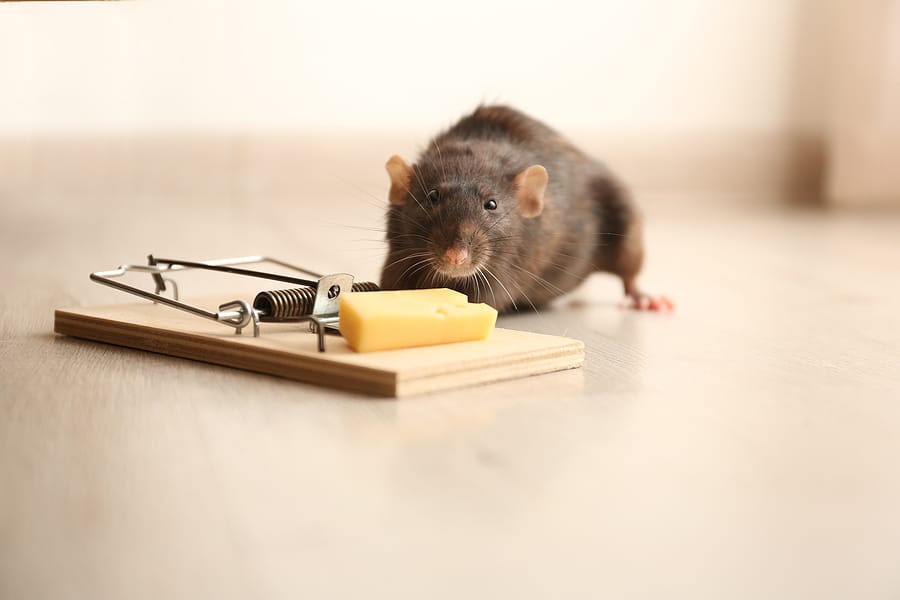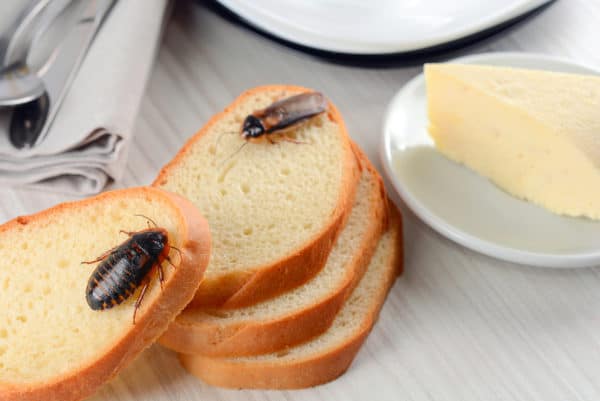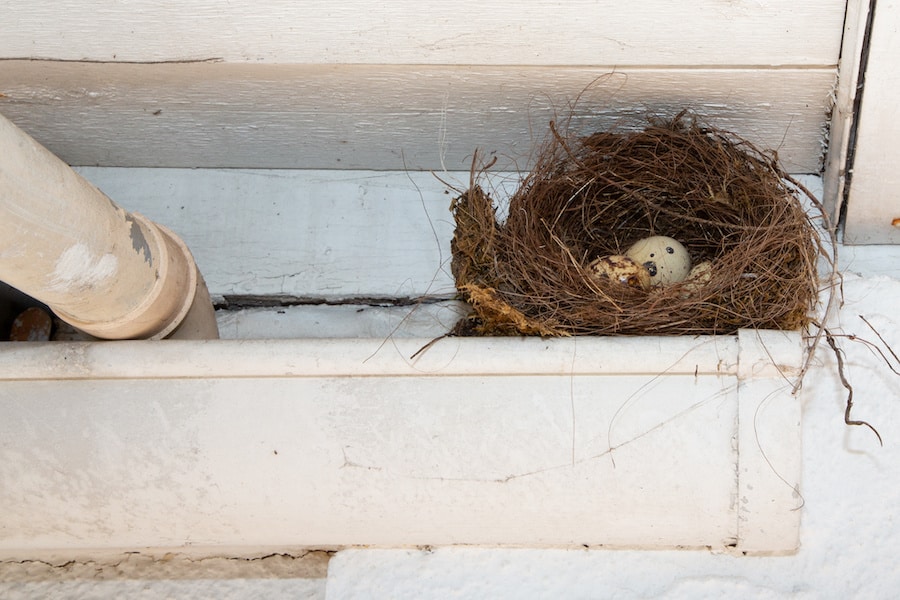READY TO GET STARTED?
REQUEST A FREE ESTIMATE
Fill out the form below or call (888) 466-7849 for a free, no-obligation estimate.

The holidays are over and we can now welcome the New Year! Like many of us, we look forward to setting some New Year’s resolutions and goals! This year many of us will look forward to saving more money, exercising more, and even working on home improvements; although one resolution you might not consider that’s both easy and effective is pest-proofing your home!. Making sure your home is protected against pests will help to keep them out for the rest of the year while also helping you stress less about pests! Here are some easy and hassle-free ways you can keep your house pest free this year!
Kitchen Clean-Up
Pests love three things: shelter, food, and water. Unfortunately for us, they can find all of these things inside our homes. Keeping a clean kitchen throughout the year can help with two of these main factors – food and water. Make sure you always clean your kitchen after cooking and eating meals. Wipe down any leftover crumbs and spills, even in hard to reach places. Store food, including pet food, in airtight containers in your pantries. Every week try to sweep up your floors and vacuum to ensure that there isn’t missed food debris on the floors.
Seal Those Gaps
Pests only need the smallest gap to enter your home and infest! Ensure pests don’t get inside by inspecting both the exterior and interior walls of your home for any open areas. If a gap is found, tightly seal it up with caulk. Make sure to also check areas where your utilities and pipes come into the home for any gaps. Finally, use screens on doors and windows, making sure they are in good repair. If a hole is found, replace the door screens and windows as soon as possible.
Don’t Forget About Outside
Pest proofing outside the home is just as important as proofing inside. Pests love clutter and debris like fallen leaves. To help declutter, clean out your gutters of debris and consider installing gutter guards to help eliminate clogs and standing water. Similarly, rake up any leaves that have fallen throughout your yard. Be sure to also keep your firewood stored at least 20 feet from your home and elevate it. If you bring the wood inside, make sure to inspect it for pests. Trim your bushes and trees back from your home where they are not touching the sides of your house. This can help with keeping pests and wildlife creatures from entering your attic.
Call A Professional
Ringing in the New Year can sometimes feel overwhelming when thinking about all the goals we want to achieve. If you want to start out the year less stressed about pests, consider calling a professional pest control company. These professionals can set you up with a scheduled treatment and prevention plan so you can focus more time on doing the things you love.

The last thing any homeowner wants is damage to their yard after all the hard work they’ve put in to get it just right. One of the most destructive pests to yards is the mole. What attracts moles to your yard? How do you get rid of them?
Moles are burrowing insectivores, feasting on a wide variety of lawn insects. They are usually about 6 to 8 inches long with gray to black velvety fur. Moles have slender, hairless snouts and small eyes and ears. They have large front feet with long claws that they use to dig through the dirt. They breed in early spring and are most active then and in the fall. Other than during mating season, moles prefer to be alone; if you have a mole problem you are usually only dealing with one.
Moles are attracted to food sources in your yard, digging through leaving behind tunnels, holes, and mounds of dirt. Moles require quite a bit of food to survive. Common signs of moles include: surface tunnels, dying grass and plants, an increase in weeds, and molehills (which are piles of dirt less than 6 inches tall and shaped like footballs or volcanoes). Moles can dig up to 18 feet per hour. As they dig they detach the roots of plants which not only allows weeds to take root but also kills the lawn, plants, and trees.
If you have a problem with moles or any other wildlife, contact your local pest control company for a comprehensive evaluation and elimination plan.
Fall Pest Control: Oriental Cockroaches

When it comes to household pests (like spiders, ants, roaches, and termites), there are several options for pest control to choose from. Should you use do it yourself pest control? Should you call a professional pest control company? What is the difference? What are the pros and cons of each? Here we break down the advantages and disadvantages of DIY vs professional pest control.
The key to effective pest control is proper identification. Appropriate treatment depends on the species of the pest, how far the infestation has spread, the size of the home, climate, and many other factors. DIY pest control products have labels with directions and warnings that are fairly simple to follow. Professionals, however, have the knowledge and training on industry trends and groundbreaking products that may not be readily available to household consumers. They know key indicators to look for and can provide quick assessments and effective treatments.
Cost is one of the biggest factors that influence DIY vs professional pest control treatments. While do it yourself products are typically less expensive than commercial products, they can end up costing you more in the long run. Most homeowners don’t treat a pest problem until they spot them; unfortunately by this point the infestation is usually already established. This could end up costing significantly more in treatment and damage repair costs than a professional service would. Professional pest control services can be more costly initially but save you over time through prevention.
DIY products are certainly convenient – you just head to your local hardware store and pick up what you need. Professional services have to be coordinated around their availability and your schedule, sometimes requiring you to be at home for the service.
Using chemicals of any kind can pose a hazard to yourself, your family, and your pets. DIY products can contain chemicals that the average consumer may not be familiar with. This can pose a threat to your and your family’s health. With a professional service the risk on the homeowner is taken away. Green pest control options are also available which are safe for both you and your pets.
The ultimate goal of any pest control treatment is effectiveness – you want it to work. With DIY methods, you usually only treat the areas where you see an active problem. These products are effective for small pest problems but typically aren’t strong enough or don’t last long enough for significant infestations. Pests are also highly adaptable and can become resistant to many chemicals used in these products. Professional pest control treatments use the most up to date methods and products. They can also treat areas where infestations have spread that you may not see such as inside walls, in attics, and crawlspaces.
DIY product guarantees will vary depending on the store or manufacturer. Most pest control companies will offer a service guarantee where they will come back and treat in between scheduled visits if a problem arises at no extra charge to the consumer.
As previously mentioned, most DIY products are designed to be used for an active problem. Oftentimes, these products aren’t used until after an infestation is already established. With a professional service, visits are set on a scheduled basis whether there is an active pest problem or not. This allows the technician to use preventative measures when infestations are gone to keep them from flourishing in your home.
When you have a pest problem, the main concern is getting it taken care of quickly and effectively whether that is through DIY methods or a professional service. Every situation is different and the main concern is the appropriate treatment for each individual situation. If you suspect you have a pest problem or would like a quote on services, contact a professional pest control company.
Why Rain and High Temperatures Bring Mosquitoes
What Are Those Little Red Bugs?
Wildlife: Leaving a Mess Behind

We know pests try to make their way into our homes, but when we see one outside of the comfort of our home we often feel a loss of control or panic. We hold businesses, hospitals, and food establishments to a higher standard due to the nature of their industries.
Because of the work they do for their customers and their communities, it is even more important for these industries to have a good, ongoing relationship with a local pest control company to ensure guests and customers feel comfortable and pest-free.
With the ever-changing food regulations designed to keep patrons safe, it is important to have a tight-knit partnership with a licensed pest control professional. Pest infestations can lead to hefty fines from health departments, increased food costs due to contaminated food, and in worse cases, the closure of the business. Pest prevention procedures and proper sanitation education for staff is essential in keeping your establishment free from pests and your reputation intact.
Hospitals, rehabilitation centers, and long-term care facilities have high standards of sanitation due to the sensitive environment for patients. Pest infestations can pose serious health threats by spreading bacteria through contamination of hospital rooms and equipment. A well-detailed pest prevention plan is crucial in keeping patients and staff healthy and safe.
Reputation drives the hospitality industry and with review sites increasing in visibility and reach, one negative review can cause a bigger impact than 10 positive ones. Nothing can be more damaging to a business than a negative review detailing a pest encounter. A relationship with a local pest control company will not only protect customers from pest infestations but also protect the reputation of your business.
Commercial pest control is a science that requires a strong partnership between the business and their local pest control company. An individualized plan is critical in protecting your important investment. If you do not already have a long-standing relationship with a pest professional, give your local company a call to set up an inspection.

Most people may not consider birds when they think of pest control; bird removal does, however, fall into the category of wildlife exclusion. While typically benign to homeowners, birds can be detrimental to both homes and health. Birds can be quite noisy, especially if they build a nest in or on your home. They can cause damage to your roof, car, and property. Their nests can block stove, dryer, and fan vents causing fire hazards and rendering them useless. Their nests can also clog gutters and drains, leading to standing water and potential damage to your roof. Their droppings contain uric acid which can damage the paint on your car. Bird droppings also contain pathogens that are dangerous to humans like histoplasmosis. Bird nests can also contain other pests such as mites, parasites, and ticks that can stick around long after the birds have left the nest.
Birds have been known to build their nests in some very inconvenient places in and around homes. They are often found above doors, over garages, inside sheds, and other high-traffic areas. They can also nest in places that are dangerous to the birds themselves – on top of lawnmowers, heat pumps, etc.
While the decision to remove the bird nest may seem simple, there are Federal laws regarding bird nest removal that make it illegal to remove certain species of birds or their nests. Best practice is always to check with a wildlife control company before attempting to remove any bird nests from your home. If you have verified that the species of bird invading your property is not protected and removal of the nest is legal and necessary, here are some steps to take to ensure both proper and safe removal and/or relocation.
The best way to eliminate bird nests from your property is to prevent them from building in the first place. Remove any food scraps and open trash from around your home as this invites them to feed. Make sure trash is secured tightly in containers. Place any bird feeders and birdbaths away from the home and further out in the yard. Only put out enough food for a few birds and clean up any spills regularly. Consider installing gutter guards to prevent nesting in gutters and downspouts. Vents are a common nesting place for birds so install vent covers and screens. Use perch repellents if necessary; these are rows of bird spikes installed on ledges, window sills, and around the perimeter of the roof to prevent birds from alighting on perches. You can also use visual repellents such as plastic owls, hawks, snakes, and even coyotes. If you use visual repellents, make sure to move them often as the birds will get used to them being in one place. Hang reflective bird diverters from strings on your porch also.
The best time to remove a nest is when it is still in the building stage. If you notice a bird nest already built or remove one this season, keep an eye out in the same area next season and stop it before it is fully completed.
Always make sure a nest is inactive before removing or relocating it. Never attempt to remove or relocate a nest if there are birds or eggs present. It is best to wait until after nesting season for any removal or relocation. Eggs in a nest without signs of the parents don’t necessarily mean the nest has been abandoned. The parents may be out feeding or they may have left to allow the eggs a chance to cool down.
The best time to remove or relocate a nest is after nesting season is over. Most birds only nest once per year; however, some species will nest 4 to 5 times. The time varies with the species of bird. Without knowing the specific species of bird, it is difficult to determine the best time to remove or relocate the nest. A professional can help identify the species you are dealing with and help determine the best time to remove the nest.
Once you have positively identified the species of bird you have, confirmed it is legal to remove the nest, and have made sure the nest is inactive and no eggs are present, you can proceed with removing or relocating the nest. Bird nests can harbor other pests and residual bird droppings that can contain dangerous pathogens for humans. Make sure to wear long sleeves, long pants, latex gloves, and a respiratory mask to protect yourself. Carefully inspect the nest to make sure it is empty of eggs and birds. Spray the nest with an antibacterial spray. Once dry, remove the nest and dispose of it in a securely sealed container or exterior trash bag. Dispose of it in the trash away from the home. Clean the area where the nest was with a strong disinfectant. Remove and dispose of your gloves. Remove your clothing and wash them immediately in hot water. Wash your hands thoroughly.
It can be difficult to determine whether or not the bird nest in or on your home is legal to remove or the best way to remove it. If you have a bird nest that is causing problems in or on your property, contact a professional wildlife exclusion company who can positively identify the species of bird you have, properly remove or dispose of the nest, and help you identify areas where nesting could be a potential issue in the future.
Request a Free Bird Control Estimate
Venomous vs Poisonous Spiders – What’s the Difference?
How Changes To Your Environment Can Help Your Pest Control
Battling a German Roach Infestation